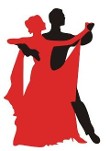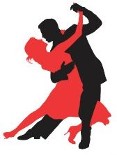Basic Dance Terminology & Definitions
amalgamation A combination of two or more patterns or movements.
American style A type of ballroom dancing which evolved from social dancing and is now a fully recognized competitive style of dancing. The 9 main American dances are divided into two groups: American Smooth: Waltz, Tango, Foxtrot, Viennese Waltz, and American Rhythm: Cha Cha, Rumba, East Coast Swing, Bolero, and Mambo
arm styling Positioning and movement of the arms, reflecting the character of a dance or style of dancing.
ball change A change of weight from the ball of one foot to the flat of the other foot.
break A stop in the music.
break step A step that changes the direction of movement. The Latin break step is a two step sequence where the first and second steps are taken in opposition. Most Latin dances use break steps.
body rise The body rises by bracing the leg muscles and stretching the spine then relaxes to a natural stance.
balance step A step in any direction, followed by a close (no weight) and a hold.
center Balance point of the body mass located near the diaphragm.
change step (or closed change) A three step sequence used to change weight from one foot to the other. Usually these steps are the first three steps of the box step.
chase A figure where one partner pursues the other. Popular in cha cha. A visual “what you see is what you do” lead
chassé A step sequence. The working leg slides out. Place weight on it and draw other leg along floor to it.
close To bring feet together without a change of weight
choreography A creation or compilation of steps, patterns and movements which make up a dance or a dance routine.
contra body movement A movement of the body which turns the opposite hip and shoulder toward the direction of the moving leg. Often used to begin turning movements. Abbreviated CBM
Cuban motion Hip motion resulting from the alternate bending and straightening of the knees.
cucarachas Alternating side breaks to the left and to the right. These are also called side breaks. In the breaking action, the feet move from first position to second position.
DanceSport The official name given to the sport of competitive ballroom dancing. Relates to the more athletic form of ballroom dancing as recognized by the Olympic Committee.
dancer’s compass A diagram that shows floor movement directions, such as “forward line if dance,” “diagonal wall,” “diagonal center,” etc.
dance position closed position: The normal hold where partners stand facing each other. In the smooth ballroom dances, partners stand very close together in body contact, slightly offset to the left. In the Latin dances, partners stand a few inches apart, either directly in front of each other or very slightly offset.
open position: Any dance position where man and lady stand apart or slightly apart, without taking a closed position dance hold.
open facing position: A variation of Open Position where man and lady stand apart, facing each other, usually with a one- or two-hand connection.
outside partner position: A variation of the Closed Position where the tracking of the man and lady's feet are slightly offset. When in Outside Partner Position, the person moving forward will step in CBMP, to the partner's right or left.
promenade position: A V-shaped dance position where both man and lady move forward and in the same direction, toward the open end of the "V”
developpé A movement in which the working leg is drawn up to the knee of the supporting leg and from there smoothly out to a position in the air, usually at 90 degrees (i.e., parallel to the floor).
fan Circular motion of the free foot.
feet, positions of There are five basic positions of the feet:
First position: feet together (feet in line with heels together, toes forward and slightly turned out.);
Second position: feet apart (feet in line, heels apart, separated by about the length of one's foot;
Third position: heel to instep (feet touching, one foot in front of the other with heel to instep);
Fourth position: normal walking step (feet apart, separated about the length of a foot, one foot in front of the other);
Fifth position: feet touching, one foot in front, heel to toe and toe to heel. Often used in a rock-step.
figure A standardized step pattern.
flex To bend slightly or relax a portion of the body. Example: the flex of the knee.
flick Sharp, quick kick backwards with a pointed toe and a flexed knee.
floor craft The ability of the leader to maneuver around the dance floor in a skilled and controlled manner as to avoid colliding with other dancers.
following The ability of the follower to react correctly to the signals given by the leader through physical and visual connections. The act of moving a fraction of a second later than the leader, and yet still be on time.
foot rise Elevation of the body through the use of the ankles, by pushing up onto the balls of the feet.
footwork The use of the five positions of the feet in dancing.
frame Posture, body position, and arm position for the purpose of maintaining connection.
free turn or free spin To turn independently without any body contact.
freeze A stop no movement.
heel lead A heel lead places the forward half of the heel onto the floor and then transfers the weight onto the rest of the foot. Used in forward steps in progressive dances.
inside turn The follower turns to the left under the leader's left hand, or turns to the right under the leader's right hand.
International Style The Internationally recognized style of ballroom dancing. For the five "standard” dances," the couples must remain in closed dance position throughout the dances. The 10 International Style dances are divided into two categories: Standard: Waltz, Tango, Viennese waltz, Slow Foxtrot, and Quickstep; and Latin: Cha Cha, Samba, Rumba, Paso Doble, and Jive.
isolation Movement of one part of the body independently of the rest.
Latin dances The partner dances originating from the Caribbean: mambo, rumba, merengue, etc.
Leading . Effective communication of intended actions by the leader through the use of leader's own body movements and through one or more physical or visual connections to the follower
line of dance The counterclockwise flow of traffic around the dance floor. The Line of Dance represents the general direction of movement overall, and is only pertinent to dances that travel continuously around the floor, such as Foxtrot, Waltz, Tango, and Samba.
lock A tight cross of the feet in 1st or 2nd position. The lock step is usually danced to triple step timing. During the step, the lower part of the legs cross such that the back leg becomes locked behind the leading leg until the leading leg moves forward. The lock step is often used in the triple step of the cha cha cha.
lunge A weight transfer to a bent leg with the other leg extended.
Modern Style Ballroom The term used to describe the ballroom dances of the International Style: waltz, foxtrot, Viennese waltz, tango, and quickstep. This term has been replaced by the term standard.
natural opposite A term used in teaching to say that one partner will be dancing the same foot positions in a particular dance pattern except in the opposite direction and on opposite feet.
natural turn A turn to the right.
open break A break step taken in open facing position, usually with the partners dancing in opposition. In other words, they both break back simultaneously.
outside turn The follower turns to the right under the leader's left hand or to the left under the leader’s right hand. See also inside turn.
picture line A dance figure (e.g. Over sway, Contra Check) characterized by changing shapes in stationary position. Also known as line.
quick A step or weight change that takes one beat of music.
reverse turn A turn to the left.
rise and fall Coming up on the toes by bracing the ankles and stretching the spine then lowering to the heels.
rock Two weight changes with the feet apart, taken in any direction.
Rhythm Category A category of dancing that include the following American Style dances danced at competitions: rumba, cha cha, bolero, mambo and swing.
shine Popular in Latin dances such as Mambo and Cha Cha, these are movements where the partners are not physically connected. Often the partners dance similar patterns while disconnected or they act out a piece of music interpretation.
slide To bring the free foot slowly together to the weighted foot.
slow A step or weight change that takes two beats of music.
Smooth Style Ballroom The term used in DanceSport events and in general to mean American Style waltz, foxtrot, tango and Viennese waltz.
split The feet move apart with the weight evenly distributed over both feet.
spotting A technique for keeping oriented and avoiding dizziness during turns. Select a spot; keep looking at it as you turn until you can't any longer; then quickly turn your head so you are looking at it again.
step The transfer of weight from one foot to another. Frequently used to mean the same thing as figure or pattern of steps.
syncopate To add or subtract steps within a specific number of beats performed by dancers to vary the normal step and to allow for personal expression and creativity.
Triple step Triple steps are popular in swing dancing. The Triple Step is a three step sequence taken on two beats of music. If the first step of the triple step is taken on count 1, the second step is taken on the half beat between counts 1&2, and the third step is taken on count 2. The step timing is often called out as 1&2. Usually the triple step is two quick steps and one slow, called out as "quick-quick-slow", or, using numbers, as "one-and-two.”
top line A posture and frame concept. The horizontal line that runs from elbow to elbow and through both shoulder blades.
Theater Arts/Cabaret Division A division at DanceSport events that involves dramatic lifts and drops usually performed by strong, highly trained dancers requiring unusual flexibility and balance.
variation A non-standard or non-syllabus step pattern. A modified version of a common step pattern











